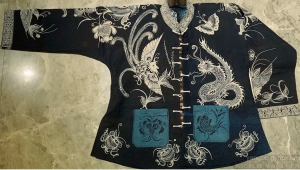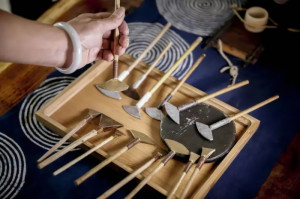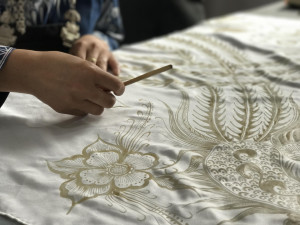Introduction
WAX PRINTING, which is know as the first printing in the East, is the most ancient handicraft in China. The pattern of the cloth is simple and natural, looks graceful, and yet is not extravagant. People make different garments with the tie-dye cloth.
Wax printing is to use wax to spot the pattern on linen, woven, cotton, wool and other fabrics, and then put it into the dye vat to dye. The wax will not dye the color, and remove the wax will show the beautiful pattern. This is an ancient anti-dyeing process in China, with a very long history.
History
More than two thousand years ago, in Qin and Han Dynasties, China began to print pictures on the cloth and dye it later. In the Tang Dynasty, products of wax printing were exported to Europe and Asia.
Development
In the past, people used hand-loomed cloth as the basic material. With the further development of economy in the Central China, new industry gradually took the place of hand-made operation. The wax printing technique was lost in one place after another. Now they use cloth produced by machines in modern factories.
But in some remote areas, such as Guizhou, this precious craft passed down generation after generation by oral instruction for two reasons. One is that the place is hard to get to so there are not much cultural exchanges. One is that the natural resources that could be used in wax printing are quite rich. For years, the product of wax printing which is simple and unrestrained, has been the ornament and decoration and clothes and rooms for the minor nationalities in Guizhou.
Materials and Tools
- Yellow wax (beeswax), Wax can be used from candles or beeswax
- Special drawing knife, to move the melted wax to fill designs
- Charcoal fire (for heating), or other heating methods
- Blank fabric, natural or vegetable fiber fabrics, such as cotton, linen and silk
- Charcoal or Pencil: For making preliminary sketch
- Cold Water, to dye and fix the wax
How to Make Wax Prints
- Plan the design
- Sketch the design in the cloth
- waxing
- make the wax pattern
- coloring
- wipe off the wax
- washing and iron
Communities in China
In China, it is believed that the art of wax printing was widespread, but nowadays, it disappeared in many, if not most, communities in China as Chinese society evolved and is was abandoned, for whatever reasons. Today there are only two communities, the Zhuang , the Buyi, the Miao ethnic groups, living in Guizhou, Guangxi, Sichuan and Yunnan Provinces, which have preserved the ancient tradition of wax printing. This comes as no surprise, as many oral traditions as well are preserved only in smaller area communities.
Advantage
The main ingredient of the dye are Radix Isatidis (a kind of herb) and indigo. Compared with chemical dye, these natural dyes are better at creating natural colors and do not fade easily.
The garment wear more comfortably and don’t negatively affect one’s skin.
The main anti-staining agent is yellow wax (beeswax). Beeswax is a secretion from the wax glands on the abdomen of bees. It is insoluble in water, but it melts when heated.
The garment are usually made of white homespun cloth woven by the people, but there are also woven white cloth, silks and poplin.








